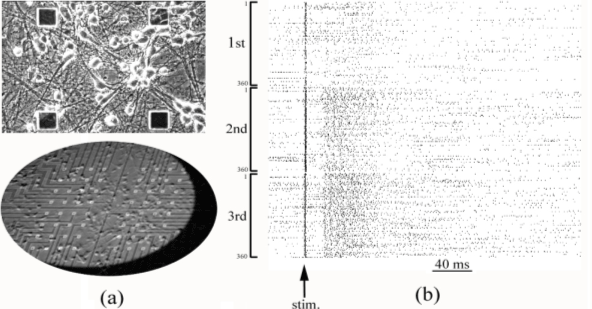Materials Science Laboratory
Å@It is widely accepted that synaptic plasticity is one of the major candidates for learning and memory in biological systems. In the central nervous system, where sparse coding is the key for information processing, the mechanisms for integrating these synaptic changes are still unknown. Here we developed cultured neuronal networks on microelectrode-array (MEA) substrates. Combining MEA based recording of neuronal activity with the novel multi-site electrical stimulation system [1], highly reliable evoked response recording was achieved. Using this system, we studied activity-dependent modification of evoked responses in cultured rat cortical neuronal networks.
Å@Cultured cortical networks showed strong spontaneous activity. Its characteristics are highly dependent on the developmental stages [2]. To detect activity-dependent changes accurately, we used stable mature networks cultured for more than two months. The cell-plated MEA was kept in the CO2 incubator. The electrical recording/stimulation system and the medium perfusion system were directly connected to the MEA in the incubator. Using continuous perfusion at a quite slow rate (0.1 ml/h), the neurons could be maintained at a steady state for some weeks. Figure 1 (a) shows the cultured neurons on the MEA. We can see that a number of neurons extended their neurites, and connected one another. Constant electrical stimulation was applied from a specific site and the evoked responses were recorded. The stimulus was applied every ten seconds. A single session consisted of 360 trials and total three sessions were carried out. Fifty three neurons could be identified by spike sorting. The evoked responses of one of the 53 neurons are shown in Fig. 1 (b) as raster plots. A certain temporal structure gradually emerged, which indicated that the reliability of the evoked response of this neuron increased. Modifications in the evoked responses of the other neurons were not uniform but we found a common rule underlying these changes.
[1] Y. Jimbo et al., IEEE Trans. Biomed. Engng. 50 (2003) 241.
[2] T. Tateno et al., Phys. Rev. E 65 (2002) 051924.
 |
|||
|